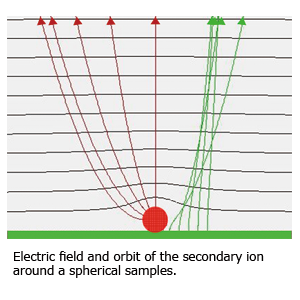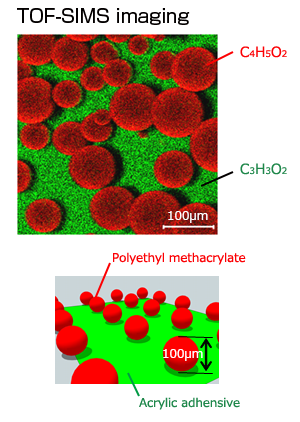 NEW
NEW
About TRIFT™ analyzers
2015.03.31 UpdateTOPICS
About TRIFT™ analyzers
TRIFT™ analyzers are unaffected by unevenness
Secondary ions emitted from a sample surface has an initial energy and an angle. Therefore, differences in time-of-flight occur even between ions with the same mass.
The occurrence of differences in times-of-flight leads to degradation of mass resolution.
The triple focusing electrostatic analyzer (TRIFT analyzer) simultaneously corrects the time-of-flight difference which occurs due to differences in initial energy and emission angle.
Simultaneous correction of time-of-flight differences caused by energy and emission angle is the most distinctive feature of the TRIFT analyzer, which achieves high mass resolution and high detection sensitivity simultaneously, while also enabling imaging with fewer shadows.
Electric field distortion due to sample shape and secondary ion orbit

Secondary ions emitted from a sample have an initial energy and an angle. Particularly when the sample shape is complex, the emission angle is greatly impacted by the electric field.
The figure on the left shows the electric field around a spherical sample placed on a flat surface and the orbit of the secondary ions. Not only are the orbits of the secondary ions emitted from the sample impacted by the electric field and largely bent, but so are those emitted from the flat surface.
Correction of differences in times-of-flight with the TRIFT™ analyzer
The TRIFT analyzer can negate the differences in times-of-flight caused by initial energy and angle.
The figure on the left is a schematic illustration of the secondary ion orbit inside the analyzer.
The black solid line is the orbit of the secondary ions without initial energy. The secondary ions with initial energy go around on the outside to negate the time-of-flight difference, which corrects the time difference caused by differences in energy.
On the other hand, this is not illustrated, but secondary ions that lose their energy due to splitting during flight go around on the internal orbit and are removed by the energy filter, resulting in a spectrum with extremely low background noise.
Ions with angles are explained next.
A secondary ion with an angle travels a longer distance before entering the analyzer compared to an ion without an angle, but as it goes around, it takes a shortcut inside the analyzer to correct for this (orange line). Those with initial energy in addition to an angle go around it (red line).
Thus, the TRIFT analyzer can correct the differences in time-of-flight caused by angle and initial energy.
Therefore, the most distinctive features of the TRIFT analyzer are that (1) it is unaffected by sample shape, (2) images without shadows can be obtained, and (3) special sampling such as flattening is not necessary.
Image of spherical sample using TRIFT™ analyzer
 The figure on the left is a TOF-SIMS image of a sample with polymer spheres scattered on an acrylic pressure sensitive adhesive. It is unaffected by the electric field around the sample, and imaging of all sides of the sphere is possible without shadows.
The figure on the left is a TOF-SIMS image of a sample with polymer spheres scattered on an acrylic pressure sensitive adhesive. It is unaffected by the electric field around the sample, and imaging of all sides of the sphere is possible without shadows.
 NEW
NEW


